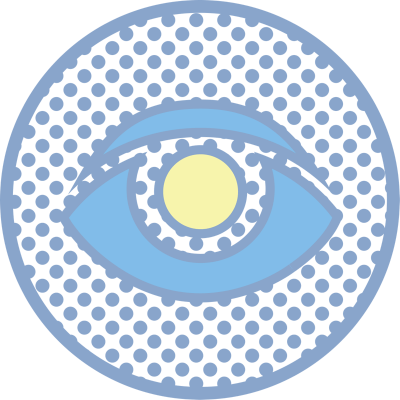What is Blepharitis (Eyelid Inflammation)?
Blepharitis is a common and chronic condition that causes inflammation of the eyelids. It can affect people of all ages and is often associated with underlying skin conditions or bacterial infections. The condition leads to irritation, redness, and discomfort along the edges of the eyelids. Blepharitis can be categorized into different types, including anterior blepharitis, posterior blepharitis, and demodex blepharitis. Effective blepharitis self-care, such as maintaining eyelid hygiene and using blepharitis eye drops, can help manage symptoms and prevent flare-ups.
Symptoms of Blepharitis (Eyelid Inflammation)
The symptoms of blepharitis vary depending on the type and severity of the condition. Common symptoms include:
-
Burning sensation, Itching, and Scaling of Eyelids
Patients often experience persistent irritation, leading to an itchy and burning sensation. The buildup of debris on the eyelids may cause crusty eyelids, leading to discomfort.
-
Crusty Eyelids
Crusting along the lash line is a hallmark symptom of blepharitis. This can cause discomfort, particularly upon waking up. In cases of squamous blepharitis, flaky skin along the eyelids is commonly observed.
-
Photophobia, Blurred Vision, and Foreign Body Sensation
Severe cases of blepharitis can lead to light sensitivity (photophobia) and blurred vision due to tear film instability. The sensation of having a foreign body in the eye is another common complaint among patients.
-
Watering of Eyes
Excessive tearing or epiphora may occur as the eye tries to counteract dryness and irritation caused by inflammation. Best eye drops for blepharitis may provide relief and hydration to the eyes.
-
Red Eye
The inflammation associated with blepharitis often causes redness, making the eyes appear irritated. Causes of blepharitis can include bacterial infections, skin conditions like rosacea, or mite infestations such as demodex blepharitis.
-
Loss of Eyelashes
Chronic blepharitis can lead to lash misalignment, thinning, or even loss of eyelashes, medically termed madarosis. Blepharitis medication may be required to prevent complications.
-
Recurrent Stye
People with blepharitis are at a higher risk of developing styes—painful, red lumps along the eyelid margin. Some cases of parasitic blepharitis can also contribute to recurrent styes and inflammation.

Causes of Blepharitis (Eylid Inflammation)?
Below we have mentioned some of blepharitis causes:
- Infection e.g. Bacterial or parasitic infection.
- Seborrheic tendency of individual (some individuals are prone for dandruff formation over scalp etc).
Types of Blepharitis
-
Staphylococcal Blepharitis
Staphylococcal blepharitis is caused by a bacterial infection—specifically, Staphylococcus bacteria. This form of blepharitis often results in red, swollen eyelids, crusting at the base of the eyelashes, and frequent eye irritation. Chronic infections may lead to complications such as loss of eyelashes (madarosis) or recurrent styes. Proper eyelid hygiene and blepharitis medication, such as antibiotic ointments or eye drops, are commonly prescribed to control the infection.
-
Seborrheic Blepharitis
Seborrheic blepharitis is associated with seborrheic dermatitis, a skin condition that causes excessive oil production and flaking. This type of blepharitis leads to greasy scales, dandruff-like flakes along the lash line, and mild redness of the eyelid margins. It is often seen in individuals with scalp dandruff, oily skin, or other seborrheic conditions. Treatment includes daily eyelid cleansing, warm compresses, and using the best eye drops for blepharitis to alleviate irritation.
-
Ulcerative Blepharitis
Ulcerative blepharitis is a severe form of blepharitis that leads to the formation of painful ulcers on the eyelid margins. It is usually caused by chronic bacterial infections or viral conditions like herpes simplex virus. Symptoms include intense pain, oozing of the eyelids, and potential scarring if left untreated. Blepharitis eye drops, antibiotic or antiviral medications, and anti-inflammatory treatments are often required to manage this condition.
-
Meibomian Blepharitis
Meibomian blepharitis, also known as posterior blepharitis, occurs when the oil-producing Meibomian glands become blocked or inflamed. This condition is commonly associated with meibomian gland dysfunction (MGD) and leads to dry eyes, irritation, redness, and foamy tears. If left untreated, Meibomian blepharitis can contribute to chronic dry eye disease. Treatment includes warm compresses, lid massage, omega-3 supplements, and prescription eye drops to restore gland function.
Treatment and Management of Blepharitis
Managing blepharitis requires a combination of home remedies and medical treatments. The following methods can help:
-
Eyelid Hygiene
Regular cleaning of the eyelids using diluted baby shampoo or special eyelid wipes can help remove debris and prevent bacterial buildup.
-
Warm Compresses
Applying a warm compress to the eyes helps loosen crusts and improves oil gland function.
-
Dawa:
Blepharitis medication, such as antibiotic ointments or steroid drops, may be prescribed for severe cases.
-
Artificial Tears & Eye Drops:
Using the best eye drops for blepharitis can provide lubrication and relief from dry eye symptoms.
-
Managing Underlying Conditions:
If causes of blepharitis include rosacea or seborrheic dermatitis, treating the root cause can improve symptoms.
By following these measures, individuals with blepharitis can effectively control their symptoms and prevent recurrent flare-ups.
What Are the Risk Factors for Developing Blepharitis?
Blepharitis can affect anyone, but certain factors increase the likelihood of developing the condition. Understanding these risk factors can help in early prevention and management.
1. Skin Conditions
Individuals with seborrheic dermatitis, rosacea, or eczema are at a higher risk of developing seborrheic blepharitis due to excessive oil production and inflammation around the eyelids.
2. Bacterial Infections
Staphylococcal blepharitis is often caused by bacterial overgrowth along the eyelid margins. People prone to staph infections or chronic eye irritation are more susceptible to this type of blepharitis.
3. Poor Eyelid Hygiene
Not cleaning the eyelids properly can lead to a buildup of debris, bacteria, and oil, which increases the risk of Meibomian blepharitis and ulcerative blepharitis.
4. Contact Lens Wearers
Frequent use of contact lenses, especially without proper hygiene, can contribute to posterior blepharitis due to increased bacterial accumulation and gland dysfunction.
5. Meibomian Gland Dysfunction (MGD)
Dysfunction of the Meibomian glands leads to blocked oil flow, which is a major contributor to posterior blepharitis and dry eye syndrome.
6. Mite Infestations (Demodex Blepharitis)
A high population of Demodex mites on the eyelashes can trigger demodex blepharitis, leading to inflammation, irritation, and crusting of the eyelids.
7. Hormonal Imbalances & Age
Aging leads to decreased oil production in the Meibomian glands, making Meibomian blepharitis more common in older adults. Hormonal changes can also contribute to gland dysfunction.
8. Environmental Factors
Exposure to dust, smoke, allergens, and pollution can aggravate the eyelids and increase the risk of allergic or irritant-induced blepharitis.
9. Use of Eye Makeup
Frequent use of eye makeup, mascara, and eyeliner without proper removal can clog the oil glands and trap bacteria, increasing the risk of anterior blepharitis.
10. Chronic Dry Eye Disease
Dry eye sufferers often experience posterior blepharitis as inadequate tear production leads to inflammation of the eyelid margins. Using the best eye drops for blepharitis can help manage this condition.
By identifying these risk factors, individuals can take proactive steps such as maintaining proper eyelid hygiene, using blepharitis medication when needed, and seeking medical advice for underlying conditions.
Know More About Itching Eyelids or Blepharitis Treatment
Itchy eyelids are a common symptom of blepharitis, a condition that causes inflammation along the eyelid margins. The itching is often accompanied by redness, burning, crusty eyelids, and a foreign body sensation. If left untreated, blepharitis can lead to complications like recurrent styes, dry eyes, and eyelash loss.
Why Do Eyelids Itch in Blepharitis?
Several factors contribute to eyelid itching, including:
-
Bacterial infections (common in staphylococcal blepharitis)
-
Excess oil production leading to clogged glands (Meibomian blepharitis)
-
Mite infestations (Demodex blepharitis)
-
Seborrheic dermatitis, which causes eye dandruff and greasy scales on the eyelashes
-
Allergies and environmental irritants
How to Relieve Itching Eyelids?
Managing itchy eyelids involves proper blepharitis treatment, including:
- Eyelid hygiene: Regularly cleaning the eyelids with warm water and a gentle cleanser helps remove crust and bacteria.
- Blepharitis eye drops: Lubricating drops help soothe irritation and prevent dry eye symptoms.
- Blepharitis medication: Antibiotic or anti-inflammatory treatments may be prescribed for severe cases.
- Warm compresses: These help open blocked oil glands, especially in posterior blepharitis.
By following these measures, itching eyelids caused by blepharitis can be effectively controlled, improving eye comfort and reducing inflammation.
Blepharitis Treatment (Eye Dandruff Treatment)
Blepharitis is often referred to as eye dandruff because it causes flaky, scaly debris along the lash line, similar to scalp dandruff. Effective treatment focuses on reducing inflammation, controlling bacterial growth, and improving eyelid hygiene.
Step-by-Step Blepharitis Treatment
-
Eyelid Cleansing
a) Use a gentle cleanser or diluted baby shampoo to clean the eyelid margins.
b) Special eyelid wipes can also help remove debris caused by seborrheic blepharitis.
-
Warm Compress Therapy
a) Applying a warm compress for 5–10 minutes helps loosen oil buildup and unclog Meibomian glands.
b)This is especially beneficial for Meibomian blepharitis and posterior blepharitis.
-
Medication for Blepharitis
a) Antibiotic ointments or drops for staphylococcal blepharitis to control bacterial infections.
b) Anti-inflammatory eye drops to reduce swelling and irritation.
c) Tea tree oil treatments to target Demodex blepharitis, which is caused by eyelash mites.
-
Use of the Best Eye Drops for Blepharitis
a) Preservative-free artificial tears can relieve dry eyes caused by blepharitis eye inflammation.
b) Medicated eye drops may be needed for more severe cases of blepharitis.
-
Lifestyle Modifications
a) Reduce makeup use to prevent bacteria buildup.
b) Avoid environmental triggers like smoke and allergens.
c) Increase intake of omega-3 fatty acids to improve oil gland function.
With consistent care and treatment, blepharitis can be managed effectively, reducing symptoms and preventing recurrence.
Below We Have Mentioned Three Types of Blepharitis Treatments in Detail
1. Home Remedies & Self-Care for Blepharitis
For mild cases, blepharitis self-care can help alleviate symptoms:
- Eyelid hygiene routine (using warm compresses and gentle cleansers)
- Regular use of artificial tears to prevent dry eyes
- Avoiding eye makeup and contact lenses during flare-ups
2. Medical Treatments for Blepharitis
For moderate to severe cases, blepharitis medication may be required:
- Antibiotic ointments and drops for staphylococcal blepharitis
- Steroid eye drops to reduce inflammation
- Tea tree oil treatments for demodex blepharitis
3. Advanced Therapies for Chronic Blepharitis
For persistent or severe cases, advanced treatments may be recommended:
- IPL (Intense Pulsed Light) therapy to improve Meibomian gland function
- LipiFlow® therapy to unclog blocked Meibomian glands
- Prescription-grade lid cleansers for demodex and seborrheic blepharitis
By following the right blepharitis treatment plan, patients can effectively manage symptoms and prevent eye dandruff buildup in the future.
Frequently Asked Questions (FAQs) about Blepharitis
What are the best eye drops for blepharitis?
The best eye drops for blepharitis depend on the underlying cause and severity of the condition. Lubricating artificial tears can help relieve dryness and irritation, while prescription anti-inflammatory or antibiotic eye drops may be required for cases caused by bacterial infections. For those with Meibomian gland dysfunction, lipid-based eye drops can restore the natural oil layer of the tear film and reduce discomfort. In cases of demodex blepharitis, medicated eye drops containing tea tree oil derivatives may be recommended to eliminate mites. It is always best to consult an eye specialist to determine the most suitable eye drops based on individual symptoms and needs.
How to treat blepharitis at home?
Treating blepharitis at home involves a consistent eyelid hygiene routine to control inflammation and prevent flare-ups. Regularly cleaning the eyelid margins with a gentle cleanser or diluted baby shampoo helps remove debris, bacteria, and excess oil. Applying warm compresses for several minutes can loosen crust and improve Meibomian gland function, especially in posterior blepharitis. Over-the-counter artificial tears can help relieve dryness, while avoiding eye makeup and contact lenses during active symptoms can prevent further irritation. Maintaining a healthy diet rich in omega-3 fatty acids may also support eyelid gland function. Home treatment requires patience, as consistent care over weeks to months is essential for long-term relief.
How long does blepharitis last?
Blepharitis is a chronic condition that can persist for weeks, months, or even a lifetime if not properly managed. The duration of symptoms varies depending on the severity of the condition, the effectiveness of treatment, and whether the underlying cause is addressed. Mild cases may improve within a few weeks with proper eyelid hygiene, warm compresses, and artificial tears, while more severe or recurrent cases may require long-term treatment with medications. In cases of demodex or bacterial blepharitis, targeted therapies such as antibiotic or tea tree oil treatments may provide relief within a few weeks. However, even after symptoms subside, ongoing maintenance is necessary to prevent recurrence.
How to cure blepharitis fast?
There is no instant cure for blepharitis, but symptoms can be managed effectively with a strict treatment routine. The fastest way to relieve irritation is by using warm compresses multiple times a day to unclog oil glands and reduce inflammation. Keeping the eyelid margins clean with specialized wipes or gentle cleansers helps remove bacterial buildup and flaky debris. Prescription eye drops or antibiotic ointments can accelerate healing in cases of bacterial infection, while medicated treatments for demodex blepharitis may provide quicker relief for mite-related inflammation. Avoiding triggers such as allergens, dust, and excessive screen time can also speed up recovery. While symptoms may improve within a few weeks, long-term maintenance is essential to prevent recurrence.
What causes Blepharitis?
Blepharitis or inflammation of eyelid usually occurs when the tiny oil glands at the base of eyelashes and eyelids become clogged. Although any individual can develop this condition, there are a few factors that increase the chances of contracting this disease. These may include: –
- Bacterial infections
- Eyelash lice or mites
- Malfunctioning or clogged glands in the eyelids
- Rosacea, which is a skin condition that causes facial redness
- Allergies to eye makeup, eye medications, or contact lens solutions
What is the Blepharitis treatment?
Your ophthalmologist may suggest you to take blepharitis medicine or use a warm compress to treat the mild conditions of this disease . Here are some of the many blepharitis treatment techniques: –
- Antibiotics – If your medical tests show that you have a bacterial infection in your eyelids, as a blepharitis treatment, you may be recommended by your doctor to take antibiotics as eye drops, ointments, or creams.
- Steroid Medication – In this blepharitis treatment technique, you may be suggested to take steroid eye drops or ointments to control the inflammation of the eyelids.
- Treatment of underlying condition – In case your Blepharitis is a consequence of another medical condition such as seborrheic dermatitis of the eyelids or rosacea, treatment of the underlying condition can help cure this disease.
- Restasis for blepharitis treatment – Restasis refers to the prescription medication that helps relieve the symptoms of this medical condition.
Can sleep be considered a part of blepharitis treatment?
Most patients with this medical condition find that the symptoms of Blepharitis are worse after sleep. The eyelids are closed for an extended period during sleep, which allows debris and oil to accumulate along the eyelids.
How is Blepharitis diagnosed?
There are a few medical tests that are conducted to diagnose Blepharitis. Your eye doctor may either carefully examine your eyelids using a magnifying glass or take a sample of crust or oil from your eyelid.
What are the different types of Blepharitis?
Blepharitis can be classified into four major types. They are: –
- Staphylococcal Blepharitis – This type of Blepharitis is caused by staphylococcus bacteria. Normally, certain types of this bacteria can live on the human body without causing any harm. However, sometimes there can be some bacterial growth or overgrowth of some types of harmful bacteria that can infect the eyelashes and eyelids.
- Seborrheic Blepharitis – The patients of seborrheic blepharitis have greasy scales or flakes around the base of eyelashes.
- Ulcerative Blepharitis – In contrast with seborrheic blepharitis, ulcerative blepharitis patients have matted, hard crusts around the eyelashes. Removing these crusts can leave small sores that ooze and bleed.
- Meibomian Blepharitis – It is a meibomian gland inflammation of eyelids that obstructs the oil glands of the eyelid. This condition is a very common cause of chronic eye redness and discomfort.
What causes Blepharitis to flare up?
In most cases, Blepharitis occurs when someone has too much bacteria on their eyelids and at the base of their eyelashes. Having bacteria on your skin is normal, but too much bacteria may cause problems. One can also contract this medical condition if the oil glands in their eyelids get irritated or clogged.
What habits can make Blepharitis worse?
Blepharitis can get worse in air-conditioned environments, cold, windy weather, prolonged computer usage, sleep deprivation, contact lens and even general dehydration. It can also worsen in the presence of active skin diseases such as acne rosacea and seborrhoeic dermatitis.
What are the differences between chronic blepharitis, anterior blepharitis, squamous Blepharitis and posterior Blepharitis?
To understand the difference between chronic blepharitis, anterior blepharitis, squamous Blepharitis and posterior Blepharitis, let us take a look at them one by one: –
- Chronic Blepharitis – It is a non infectious inflammation with an unknown cause. In this type of blepharitis, a gland called meibomian in our eyelids produces altered lipid secretion that causes the evaporation of tears.
- Anterior Blepharitis – It is commonly caused by bacteria, eyelash dandruff, or scalp dandruff. If this bacteria is present in excess amount, infection can occur.
- Squamous Blepharitis – It is a type of blepharitis that is caused by bacterias such as staphylococcus aureus and staphylococcus epidermidis.
- Posterior Blepharitis – This type affects the inner edge of our eyelids which happens when oil glands get clogged.

Usipuuze shida ya macho!
Sasa unaweza kufikia madaktari wetu wakuu kwa kuweka nafasi ya mashauriano ya video mtandaoni au miadi ya hospitali
Weka miadi sasa